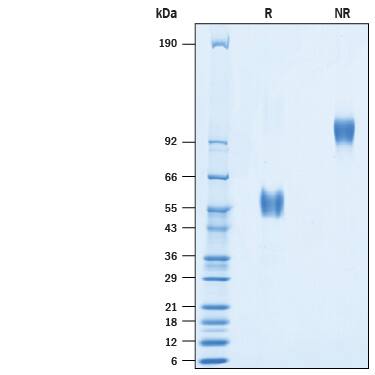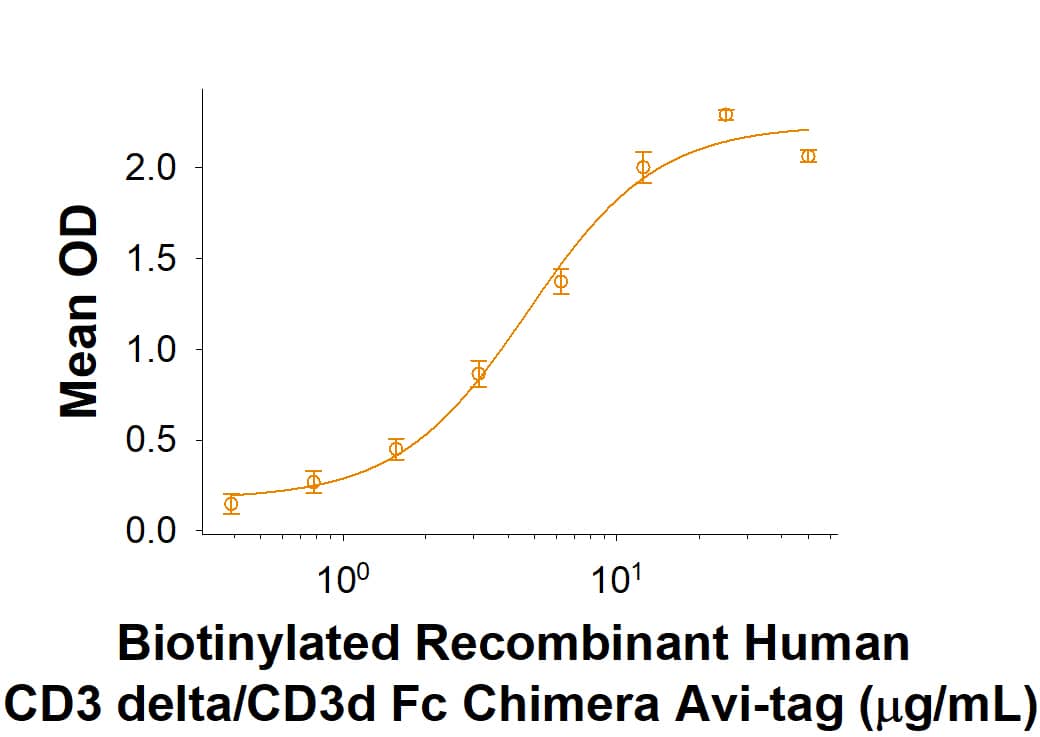Recombinant Human CD3 delta/CD3d Fc Avi-tag Protein, CF
R&D Systems, part of Bio-Techne | Catalog # AVI10280
Biotinylated

Key Product Details
Learn more about Avi-tag Biotinylated Proteins
Source
CHO
Accession #
Structure / Form
Disulfide-linked homodimer, biotinylated via Avi-tag
Conjugate
Biotin
Applications
Bioactivity
Product Specifications
Source
Chinese Hamster Ovary cell line, CHO-derived human CD3 delta/CD3d protein
| Human CD3 delta/CD3d (Phe22-Ala105) Accession # P04234.1 |
IEGRMD | Human IgG1 (Pro100-Lys330) |
Avi-tag |
| N-terminus | C-terminus | ||
Purity
>95%, by SDS-PAGE visualized with Silver Staining and quantitative densitometry by Coomassie® Blue Staining.
Endotoxin Level
<0.10 EU per 1 μg of the protein by the LAL method.
N-terminal Sequence Analysis
Phe22
Predicted Molecular Mass
38 kDa
SDS-PAGE
54-61 kDa, under reducing conditions
Activity
The biotin to protein ratio is greater than 0.7 as determined by the HABA assay.
Measured by its binding ability in a functional ELISA.
When Recombinant Human CD3 epsilon Fc Chimera Protein (Catalog # 9850-CD) is immobilized at 10 μg/mL, 100 μL/well, the concentration of Biotinylated Recombinant Human CD3 delta/CD3d Fc Chimera Avi-tag (Catalog # AVI10280) that produces 50% of the optimal binding response is approximately 2.0-14 μg/mL.
Measured by its binding ability in a functional ELISA.
When Recombinant Human CD3 epsilon Fc Chimera Protein (Catalog # 9850-CD) is immobilized at 10 μg/mL, 100 μL/well, the concentration of Biotinylated Recombinant Human CD3 delta/CD3d Fc Chimera Avi-tag (Catalog # AVI10280) that produces 50% of the optimal binding response is approximately 2.0-14 μg/mL.
Scientific Data Images for Recombinant Human CD3 delta/CD3d Fc Avi-tag Protein, CF
Biotinylated Recombinant Human CD3 delta/CD3d Fc Chimera Avi-tag Protein Binding Activity.
When Recombinant Human CD3 epsilon Fc Chimera Protein (9850-CD) is immobilized at 10 μg/mL, 100 μL/well, the concentration of Biotinylated Recombinant Human CD3 delta/CD3d Fc Chimera Avi-tag (Catalog # AVI10280) that produces 50% of the optimal binding response is approximately 2.0-14 μg/mL.Biotinylated Recombinant Human CD3 delta/CD3d Fc Chimera Avi-tag SDS-PAGE.
2 μg/lane of Biotinylated Recombinant Human CD3 delta/CD3d Fc Chimera Avi-tag (Catalog # AVI10280) was resolved with SDS-PAGE under reducing (R) and non-reducing (NR) conditions and visualized by Coomassie® Blue staining, showing bands at 54-61 kDa and 108-122 kDa, respectively.Formulation, Preparation and Storage
AVI10280
| Formulation | Lyophilized from a 0.2 μm filtered solution in PBS with Trehalose. |
| Reconstitution | Reconstitute at 500 μg/mL in PBS. |
| Shipping | The product is shipped at ambient temperature. Upon receipt, store it immediately at the temperature recommended below. |
| Stability & Storage | Use a manual defrost freezer and avoid repeated freeze-thaw cycles.
|
Background: CD3 delta/CD3d
References
- Gil, J. et al. (2011) J. Clin. Invest. 121:3872.
- Carson, G.R. et al. (1991) J. Biol. Chem. 266:7883.
- Birnbaum, M.E. et al. (2014). Proc. Natl. Acad. Sci. USA. 111:17576.
- Wucherpfennig, K. et al. (2010). Cold Spring Harb Perspect. Biol. 2:a005140.
- Kim, S.T. et al. (2010) J. Immunol. 185:2951.
- Holst, J. et al. (2008) Nat. Immunol. 9:658.
Long Name
CD3 delta
Alternate Names
CD3D
Gene Symbol
CD3D
UniProt
Additional CD3 delta/CD3d Products
Product Documents for Recombinant Human CD3 delta/CD3d Fc Avi-tag Protein, CF
Product Specific Notices for Recombinant Human CD3 delta/CD3d Fc Avi-tag Protein, CF
For research use only
